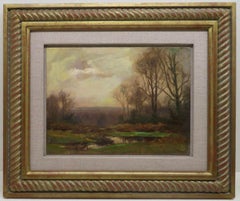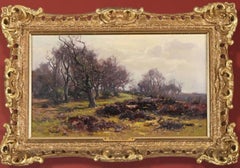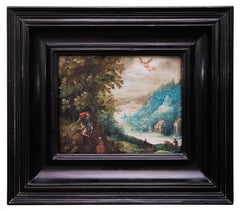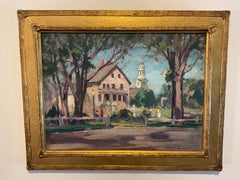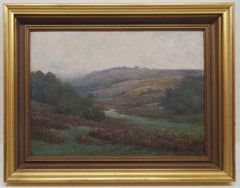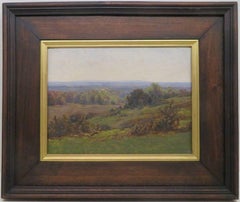Frederick Golden Short Art
to
2
Overall Width
to
Overall Height
to
1
1
1
1
2
2
2
2
10,138
2,779
1,375
1,369
2
2
Artist: Frederick Golden Short
1863-1936 English Impressionist signed Oil painting NEW FOREST SUNSET HAMPSHIRE
By Frederick Golden Short
Located in Cirencester, GB
ARTIST: Frederick Golden Short (1863-1936) British
TITLE: "New Forest Sunset"
SIGNED: unsigned - labelled verso for Louise Kosman Gallery where originally purchased
MEDIUM: oil on ...
Category
Mid-20th Century Post-Impressionist Frederick Golden Short Art
Materials
Oil
New Forest, Hampshire, 19th century, landscape oil, by Frederick Golden Short
By Frederick Golden Short
Located in York, GB
New Forest,Hampshire, 19th century,landscape oil, by Frederick Golden Short
A fine small framed landscape oil painting on canvas o...
Category
19th Century Old Masters Frederick Golden Short Art
Materials
Oil
Related Items
Abraham and the Sacrifice of His Son Isaac by Adriaen Van Stalbemt, C. 1605-1610
Located in Stockholm, SE
Artist: Adriaen van Stalbemt (Stalbempt) 1580-1662
Title: Abraham and the Sacrifice of His Son Isaac “Das Opfer des Abraham”
According to the Old...
Category
Early 1600s Old Masters Frederick Golden Short Art
Materials
Copper
New England Town Scene Oil Painting by listed artist Emile Gruppe (1896-1978)
Located in Baltimore, MD
Emile Albert Gruppe was a very well known Cape Ann, Massachusetts painter who founded his own Gruppe Summer School in 1942. He was born in Rochester, NY in 1896 and studied at the A...
Category
1930s Post-Impressionist Frederick Golden Short Art
Materials
Oil
$5,440 Sale Price
20% Off
H 12 in W 16 in D 1 in
Shepherd with Sheep, Cows and a Goat in a Landscape by Jan Frans Soolmaker
Located in Stockholm, SE
This painting depicts a pastoral scene that is attributed to the artist Jan Frans Soolmaker, an artist known for his Italianate landscapes and scenes that often feature equestrian and Arcadian elements. The painting is not signed but is attributed to Soolmaker, relating it to a known signed work by the artist that was sold at Sotheby’s London in 1999.
The scene is suffused with the warm glow of a setting or rising sun, casting a soft light that is characteristic of Soolmaker’s landscapes. It shows a shepherd guiding a group of cattle across a shallow stream, with the animals taking center stage in the composition. The animals are rendered with careful attention to their forms and the play of light on their bodies, which is a hallmark of Soolmaker's work. The landscape is composed of a rocky terrain with trees and shrubbery, creating a sense of depth and natural beauty that invites the viewer to explore the scene further.
The background suggests a vast, open landscape with distant mountains, which adds to the Italianate feel of the painting. The sky is dramatic, with clouds catching the light of the sun, contributing to the overall serene yet dynamic atmosphere of the work.
The provenance of the painting is notable, having been in the possession of significant historical figures such as Swedish Prince Fredrik Adolf, and later The collection of Pär Ulmgren, The collection of Gösta Stenman, and Engineer and politician Gustaf Henry Hansson.
Potential buyers have the option of choosing between a newly made gold frame or an older brown frame, which allows for personalization in how the work is presented.
Soolmaker’s work is often compared to that of Dutch painter Nicolaes Berchem, whose style he emulated. Soolmaker's landscapes reflect a similar sensitivity to light and composition, making his works sought after for their beauty and historical significance. Despite the smaller body of work left by Soolmaker, due to his short career, his paintings are valued for their craftsmanship and the legacy of the artist’s brief but impactful contribution to the Dutch Italianate landscape genre.
Information:
Jan Frans Soolmaker (Flanders 1635‑1685)
Shepherd with Sheep...
Category
17th Century Old Masters Frederick Golden Short Art
Materials
Canvas, Oil
$4,323 Sale Price
20% Off
H 22.05 in W 20.87 in
Emile Chaumont (1877-1927) - Summer landscape in Dordogne
Located in BELEYMAS, FR
Emile CHAUMONT
(Perigueux 1877 - 1927)
Summer landscape in Périgord
Oil on panel
H. 32 cm; L. 41 cm
Signed lower left, dated 1912
Provenance: Private c...
Category
1910s Post-Impressionist Frederick Golden Short Art
Materials
Oil, Panel
$1,441
H 12.6 in W 16.15 in
Old Master Oil on Wood 17th Century Flemish Netherlands Holland
Located in Eltville am Rhein, DE
Dutch Master
17th Century
Farmer at the Well with Goats and Cows
Oil on Wood
Size: approx. 48 x 63 cm
Frame: 68 x 83 cm
Age-related condition, old restorations (see photos)
Viewing...
Category
17th Century Old Masters Frederick Golden Short Art
Materials
Oil
Flemish Early 17th Century Old Master Oil on Panel Painting Hunting Scene 1620
Located in Portland, OR
A highly important Flemish Old Master oil painting by Peter Van Lint (1609-1690), titled "Preparing for the Hunt", the painting is dated & signed by the artist, 1620. The painting wa...
Category
1620s Old Masters Frederick Golden Short Art
Materials
Oil, Panel
$27,500
H 21.75 in W 26 in D 2.5 in
Landscape Near Felday, Surrey
By Abraham Hulk the Younger
Located in Hillsborough, NC
Dutch/English artist Abraham Hulk the Younger (1851-1922) is most known for landscapes of the British countryside. This work is one of a pair (the second work is also available by s...
Category
Late 19th Century Old Masters Frederick Golden Short Art
Materials
Canvas, Oil
$1,960 Sale Price
30% Off
H 27 in W 22.75 in D 2.13 in
"Earthly Paradise" Frédérick Bouttats (Antwerp, 1590-1661)- Studio of
Located in SANTA FE, NM
The Earthly Paradise
Frédérick Bouttats (Antwerp, 1590-1661)
Painting is Circa 1610-1612
Oil on wood panel, circa 42 7/8 x 29 3/8 (ca. 52 x 39 frame) inches
The inner frame is c18th ...
Category
1610s Old Masters Frederick Golden Short Art
Materials
Oil, Wood Panel
$57,500
H 39 in W 52 in
Period Marine Landscape Credited to Warren Sheppard
By Warren W. Sheppard
Located in Roma, IT
This beautiful painting, due to its very high quality of execution, style and era, can be referred to the great artist Warren Sheppard, who specialized in seascapes.
Of great evocati...
Category
19th Century Old Masters Frederick Golden Short Art
Materials
Canvas, Oil
$3,362
H 15.75 in W 21.46 in D 2.76 in
Allegory of Abundance
Located in New York, NY
Painted in collaboration with Hendrick van Balen (Antwerp, 1575 – 1632).
Provenance: Private Collection, Uruguay, since the 1930s.
The eldest son of Jan Br...
Category
17th Century Old Masters Frederick Golden Short Art
Materials
Copper
Vintage Palm Springs Area Canyon Landscape Oil Painting by Suzanne Dallons
Located in Baltimore, MD
This is an unusual painting of a canyon in the Palm Springs area of Southern California. In the foreground is a blooming native plant, with a nice close up view. Think of it as a p...
Category
1960s Post-Impressionist Frederick Golden Short Art
Materials
Oil
$485
H 17 in W 21 in D 3 in
Shipping in Stormy Waters, Attributed to Italian Artist Francesco Guardi
By Francesco Guardi
Located in Stockholm, SE
The splendour of the tragic sea
Francesco Guardi and maritime painting in Venetian art
No Venetian painter was a stranger to the sea. After all, Venice was not only one of the most prominent ports of the Mediterranean, but indeed a city literally submerged in the ocean from time to time. Curiously however, the famous Venetian school of painting showed little interest in maritime motifs, favouring scenes from the iconic architecture of the city rather than seascapes. That is why this painting is a particularly interesting window into not only the painter Francesco Guardi himself – but to the significance of the element of water in art history, in absence as well as in the centre of attention.
Whether it be calm, sunny days with stunning views of the palaces alongside the canals of Venice or – more rarely – stormy shipwrecking tragedies at sea, water as a unifying element is integral to the works of painter Francesco Guardi (1712–1793). During his lifetime, Venetian art saw many of its greatest triumphs with names like Tiepolo or Canaletto gaining international recognition and firmly establishing Venice as one of the most vibrant artistic communities of Europe. While the city itself already in the 18th century was something of an early tourist spot where aristocrats and high society visited on their grand tour or travels, the artists too contributed to the fame and their work spread the image of Venice as the city of romance and leisure to an international audience, many of whom could never visit in person.
Still today, the iconic image of Venice with its whimsical array of palaces, churches and other historic buildings is much influenced by these artists, many of whom have stood the test of time like very well and remain some of the most beloved in all of art history. It was not primarily subtility, intellectual meanings or moral ideals that the Venetian art tried to capture; instead it was the sheer vibrancy of life and the fast-paced city with crumbling palaces and festive people that made this atmosphere so special. Of course, Venice could count painters in most genres among its residents, from portraiture to religious motifs, history painting and much else. Still, it is the Vedutas and views of the city that seems to have etched itself into our memory more than anything else, not least in the tradition of Canaletto who was perhaps the undisputed master of all Venetian painters.
Born into his profession, Francesco lived and breathed painting all his life. His father, the painter Domenico Guardi (1678–1716) died when Francesco was just a small child, yet both he and his brothers Niccolò and Gian Antonio continued in their fathers’ footsteps. The Guardi family belonged to the nobility and originated from the mountainous area of Trentino, not far from the Alps. The brothers worked together on more challenging commissions and supported each other in the manner typical of family workshops or networks of artists. Their sister Maria Cecilia married no other than the artist Giovanni Battista Tiepolo himself, linking the family to the most renowned Venetian name of the time. During almost a decade, Guardi worked in the studio of Michele Giovanni Marieschi, sometimes simply known as Michiel, a painted similar in both style and motif. Canaletto is, however, the artist Guardi is most often compared to since they shared a mutual fascination for depicting the architecture and cityscape of Venice.
During the course of his career, Guardi tried his hand in many different genres. He was as swift in painting landscapes, Vedutas of Venice, sacred motifs, interiors and architectural compositions as he was in a number of other motifs. His style is typical of the Venetian school but also distinct and personal once we look a little closer. There is an absolute certainty in the composition, the choice of which sometimes feels like that of a carefully calculated photograph – yet it is also very painterly, in the best sense of the word: fluid, bold, sensitive and full of character. The brushwork is rapid, intense, seemingly careless and extraordinarily minute at the same time; fresh and planned in a very enjoyable mixture. His interiors often capture the breath-taking spacious glamour of the palaces and all their exquisite decor. He usually constructed the motif through remarkably simple, almost spontaneous yet intuitively precise strokes and shapes. The result was a festive, high-spirited atmospheric quality, far away from the sterile and exact likeness that other painters fell victim to when trying to copy Canaletto.
The painting here has nothing of the city of Venice in it. On the contrary, we seem to be transported far away into the solitary ocean, with no architecture, nothing to hold on to – only the roaring sea and the dangerous cliffs upon which the ships are just moments away from being crushed upon. It is a maritime composition evoking both Flemish and Italian precursors, in the proud tradition of maritime painting that for centuries formed a crucial part of our visual culture.
This genre of painting is today curiously overlooked, compared to how esteemed and meaningful it was when our relationship to the sea was far more natural than it is today. When both people and goods travelled by water, and many nations and cities – Venice among them – depended entirely on sea fare, the existential connection to the ocean was much more natural and integrated into the imagination. The schools and traditions of maritime art are as manifold as there are countries connected to the sea, and all reflect the need to process the dangers and wonders of the ocean.
It could symbolize opportunity, the exciting prospects of a new countries and adventures, prospering trade, beautiful scenery as well as war and tragedy, loss of life, danger and doom. To say that water is ambivalent in nature is an understatement, and these many layers were something that artists explored in the most wondrous ways. Perhaps it takes a bit more time for the modern eye to identify the different nuances and qualities of historic maritime paintings, they may on first impression seem hard to differentiate from each other. But when allowing these motifs to unfold and tell stories of the sea in both fiction and reality – or somewhere in between – we are awarded with an understanding of how the oceans truly built our world.
In Guardi’s interpretation, we see an almost theatrically arranged shipwrecking scene. No less than five ships are depicted right in the moment of utter disaster. Caught in a violent storm, the waves have driven them to a shore of sharp cliffs and if not swallowed by the waves, crushing against the cliffs seems to be the only outcome. The large wooden ships are impressively decorated with elaborate sculpture, and in fact relics already during Guardi’s lifetime. They are in fact typical of Dutch and Flemish 17th century ships, giving us a clue to where he got the inspiration from. Guardi must have seen examples of Flemish maritime art, that made him curious about these particular motifs. One is reminded of Flemish painters like Willem van de Velde and Ludolf Backhuysen, and this very painting has indeed been mistakenly attributed to Matthieu van Plattenberg...
Category
18th Century Old Masters Frederick Golden Short Art
Materials
Canvas, Oil
$70,858
H 25.79 in W 29.14 in
Previously Available Items
(1863-1936) English Impressionist signed Oil painting NEW FOREST HAMPSHIRE
By Frederick Golden Short
Located in Cirencester, GB
ARTIST: Frederick Golden Short (1863-1936) British
TITLE: "New Forest Landscape Hampshire"
SIGNED: lower right
MEDIUM: oil on board
SIZE: 43cm x 46cm inc frame
CONDITION: very go...
Category
Mid-20th Century Post-Impressionist Frederick Golden Short Art
Materials
Oil
H 14.18 in W 18.12 in D 1.97 in
Original Antique English oil painting NEW FOREST HAMPSHIRE by F. Golden Short
By Frederick Golden Short
Located in Cirencester, GB
ARTIST: Frederick Golden Short (1863-1936) British
TITLE: "New Forest Landscape Hampshire"
SIGNED: lower right
MEDIUM: oil on board
SIZE: 47cm x 40cm inc frame
CONDITION: very go...
Category
Early 20th Century Impressionist Frederick Golden Short Art
Materials
Oil
H 15.75 in W 18.51 in D 1.58 in
Original fine ANTIQUE ENGLISH signed oil painting NEW FOREST SCENE HAMPSHIRE
By Frederick Golden Short
Located in Cirencester, GB
Artist: Frederick Golden Short (1863-1936) British
Title: "New Forest Landscape"
Medium: oil on board
Size: 35cm x 29cm inc frame
Condition: very good
Notes: F G Short was born in ...
Category
Mid-20th Century Impressionist Frederick Golden Short Art
Materials
Oil
(1862-1936) New Forest Original English Landscape Oil Painting SIGNED
By Frederick Golden Short
Located in Cirencester, GB
ARTIST: Frederick Golden Short (1863-1936) British
TITLE: “New Forest Landscape Hampshire ”
SIGNED: lower right
MEDIUM: oil on board
SIZE: 32cm x 27cm inc frame
CONDITION: excel...
Category
Early 20th Century Impressionist Frederick Golden Short Art
Materials
Oil
Frederick Golden Short (1863-1936) - A Pair of Oils, Forest Scenes
By Frederick Golden Short
Located in Corsham, GB
A pair of forest landscapes, possibly in the New Forest which the artist frequently painted. One features a river to the left of the composition. One of the paintings is signed on th...
Category
20th Century Frederick Golden Short Art
Materials
Oil
Frederick Golden Short art for sale on 1stDibs.
Find a wide variety of authentic Frederick Golden Short art available for sale on 1stDibs. You can also browse by medium to find art by Frederick Golden Short in oil paint, paint and more. Much of the original work by this artist or collective was created during the 20th century and is mostly associated with the Impressionist style. Not every interior allows for large Frederick Golden Short art, so small editions measuring 6 inches across are available. Frederick Golden Short art prices can differ depending upon medium, time period and other attributes. On 1stDibs, the price for these items starts at $510 and tops out at $548, while the average work can sell for $529.
